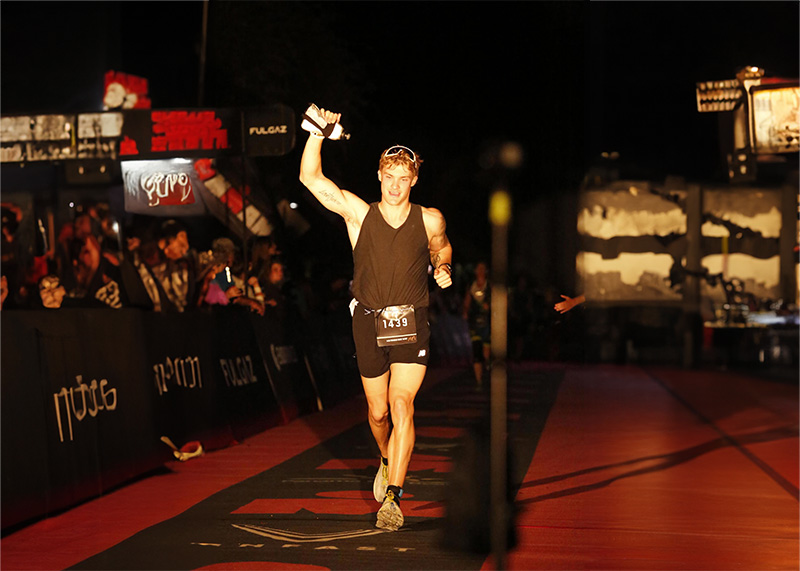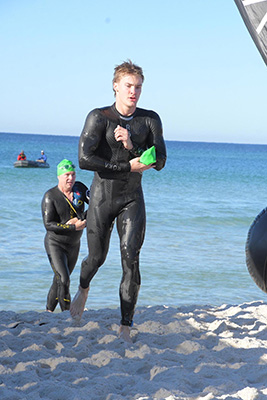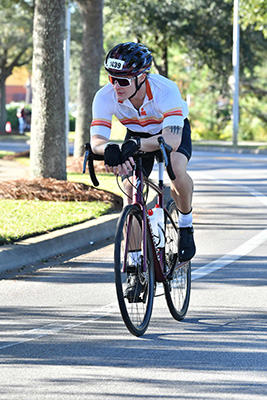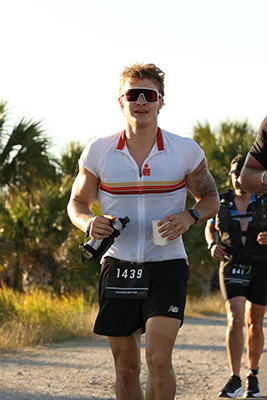
CJ (Christian) Weber ’24 completed his first Ironman Triathlon—a 2.4-mile swim, followed by a 112-mile bike ride, and a 26.2-mile run—in Panama City Beach, Florida, on November 4, 2023.
The Ironman Triathlon starts with a 2.4-mile swim, followed by a 112-mile bike ride, and a 26.2-mile run (a marathon). The swim part is the most dangerous, especially at Ironman Florida in Panama City Beach, where it takes place in the ocean, not a lake or swimming pool. What’s worse, once all the swimmers are in the water, everyone is thrashing around as they try to break away from the pack of bodies. It can be harrowing. Some people start to hyperventilate; some even throw up.

Even though CJ Weber had never swum in the ocean before he competed in his first Ironman Triathlon in Panama City Beach, he didn’t let the watery melee bother him. “If you look around and see that and start freaking out, then it’s gonna make it so much worse,” Weber says. “I just learned to control my mind and relax and accept everything going on around me.”
As Weber stood on the beach before the start of the swim, he kept repeating “cool, calm, confident” in his head. “That’s the mantra I used on race day, but I also used it in training through the whole eight-month process.”
Before he competed in the Ironman, Weber had no idea what it even was, so his decision to do it came as somewhat of a surprise, especially to himself. Even though he was a standout basketball player, he wasn’t a runner or swimmer and had never done any type of endurance race in his life.

“I was on the fence about stopping playing basketball at Moravian because I wanted to work and make more money so I wouldn’t have to move in with my parents after graduation,” Weber says. “But then one of my buddies, Ty Mozeleski ’23, was like, “Since you’re not playing basketball, you want to do an Ironman with me?”
CJ agreed and followed an eight-month training plan religiously: two workouts a day Monday through Thursday, and one workout each on Friday and Saturday. “Monday would be a swim and a run, and Tuesday would be a lift and a brick,” Weber says. “A brick is the transition from the bike into the run—they call it a brick because your legs feel like bricks when you get off the bike and start running.
“Wednesday is another swim and a bike, Thursday is a run and lift, Friday would be a long bike ride, and then Saturday would be a long run.”
As harrowing as the swim part of the Ironman was, the marathon portion was especially challenging for Weber’s equanimity of mind. “Ten miles in and I was like, Wow, I have 16 miles to go—my mind went to dark places,” Weber says. “Of course I’d think negative things, but I would never say them out loud. I would never bring them to reality.”

Thankfully, Weber had his family there to support him and help keep his mind focused. The marathon run followed a loop, and runners would do it twice. When Weber got to the end of the first loop at mile 13.1, where you can either turn right to the finish line or left to run the remaining 13.1 miles, he saw his parents cheering him on.
“It was so emotional. Every time I would get a mile closer to the finish line, I would almost start to tear up,” Weber says. “The last block is packed with people screaming for you, so it’s hard not to just book it.”
At the end of that long day of triathlon torture, Weber was in the worst pain in his life, and he told himself he’d never do anything like that again.
“But then the next morning, I signed up to do a Half Ironman, 70.3 miles, in Maryland next summer,” Weber says. “The journey to me is what is so amazing—the eight months of every single day, no matter how you feel, getting up and doing the work over and over. That process is what gives me fulfillment.”—Steve Neumann ’94, G’18